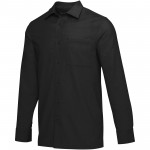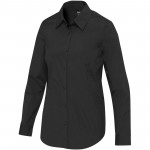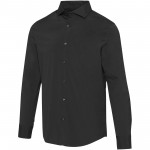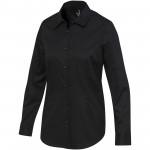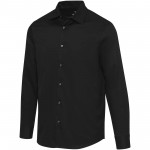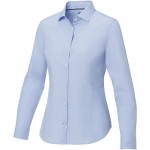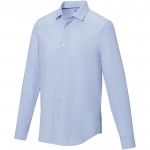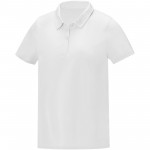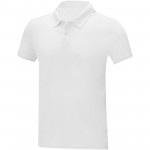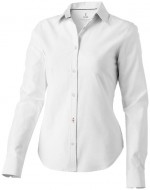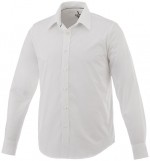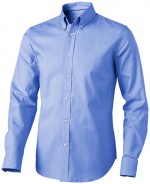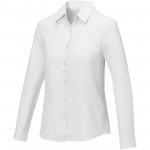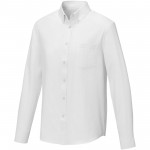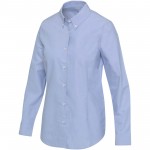WE CHANGE FOR YOU! More products, more information, easier ordering and ALWAYS CURRENT OFFER !!!
We are at your disposal from Monday to Friday between 8:00 AM and 4:00 PM
Logo Print Shirt: The Ultimate Guide to Corporate Print Shirts
A shirt with a logo print is a popular choice among companies that want to strengthen their visual identification and promote their brand. In this comprehensive guide, we'll discuss various aspects of corporate logo shirts, such as their benefits, the types of shirts available, the process of creating prints and embroidery, and practical tips for using logo shirts in your marketing campaigns. .
What is a shirt with a company print?
A shirt with a company print is a clothing part of the company's visual identification, on which a logo or other graphic elements related to the brand are placed. Shirts with company prints have a promotional function and strengthen the sense of belonging to a team among employees. Depending on your needs, printed shirts can be used as elements of employee clothing, gifts for customers or as part of an advertising campaign.
Definition and use of printed shirts
Printed shirts are clothing on which various graphics, logos or inscriptions are placed. Prints can be advertising, informational, artistic or any other, depending on the needs and goals. Shirts with prints are used in many areas, such as:
- promotion and advertising of companies,
- visual identification of teams and organizations,
- kill employees in workplaces
- gifts for clients and business partners
- merchandising of artists and music bands,
- commemorative T-shirts related to events, holidays or social campaigns.
Differences between a printed shirt and an embroidered shirt
In the case of corporate shirts, a dilemma often arises: shirt with embroidery or print. Both solutions have their advantages and disadvantages, which are worth considering before making a decision.
Shirt with a print Shirt with embroidery Possibility to produce any complex patterns and colors Limitations in the implementation of complex patterns and colors Affordable price, especially in larger quantities Higher price, especially in small quantities The print may wear off and fade as a result of washing and use The embroidery is durable and resistant to abrasion and washing Possibility of printing on various materials The best effects on materials with a smooth structure Faster production process The embroidery process may be time-consuming
The choice between a printed shirt and an embroidered shirt depends on individual needs and expectations. Printing may be a better solution for companies that want to achieve eye-catching and colorful patterns, while embroidery may be suitable for companies that value elegance and durability.
Advantages of using logo printed shirts
Company shirts with a logo are an excellent promotional tool that can bring many benefits to companies. Strengthening brand identification, promotion and building customer loyalty are just some of them. In the following sections, we will discuss how logo printed shirts can help you achieve these goals.
How can shirts with a logo strengthen your brand identification?
Shirts with your logo can significantly contribute to building brand recognition and customer loyalty. Employees wearing shirts with the company logo become living advertisements that attract the attention of potential customers. In addition, shirts with logos:
- They strengthen the sense of belonging to a team among employees, which may translate into greater commitment and efficiency,
- They facilitate the identification of employees by customers, which may affect the perception of the company's professionalism,
- They emphasize the consistency of the company's image, which can increase customer trust,
- They create the opportunity to promote the company in various situations, such as fairs, conferences or business meetings.
It is worth investing in shirts with a logo to strengthen brand identification and build lasting relationships with customers.
Promotional shirts with a logo as a marketing tool
Promotional shirts with a logo are an effective marketing tool that can contribute to increasing brand recognition and sales. The use of promotional shirts with a logo can bring the following benefits:
- An easy way to reach a wide group of recipients, thanks to wearing shirts by employees, customers and event participants,
- Possibility of using promotional shirts as gifts for customers, which may affect their loyalty and positive associations with the brand,
- Creating a lasting advertising message that will be visible for a long time, unlike one-off advertisements
- Increased employee engagement, who will be proud of wearing shirts with their company logo.
To sum up, advertising shirts with a logo are an excellent marketing tool that can help to strengthen brand identification, increase customer loyalty and promote the company in various situations.
Types of printed shirts available on the market
Corporate shirts with prints are available in various types that can be tailored to the needs of the company and the individual preferences of employees. In this chapter, we will discuss the different types of printed shirts, including men's and women's shirts, business shirts, and casual shirts.
Men's shirts with tops rukiem versus women's shirts with prints
Men's shirts with prints and women's shirts with prints differ primarily in cut and style. Men's shirts usually have a straighter cut, wide shoulders and longer sleeves, while women's shirts are more form-fitting, with narrower shoulders and shorter sleeves. It is worth paying attention to these differences when ordering printed shirts for your company to ensure wearing comfort for all employees.
The similarities between men's and women's printed shirts include the materials they are made from and the printing techniques. In both cases, you can choose between cotton, polyester or a mixture of these materials, as well as various printing techniques, such as screen printing, digital printing or thermal transfer.
Business shirts with a logo versus casual shirts with a print
Business shirts with a logo and casual shirts with prints differ primarily in style and purpose. Business shirts are more elegant, with long sleeves, collars and cuffs, making them suitable for wearing in formal situations such as business meetings or conferences. Casual shirts, on the other hand, have a looser cut, short sleeves and no collar, which makes them ideal for everyday wear, during promotional events or as an element of employee attire in less formal work environments.
In the case of business shirts with a logo, the print can be placed in a more discreet place, such as on a pocket or cuff, to maintain the elegant appearance of the shirt. However, casual shirts with a print allow for greater freedom in the location of the print, e.g. on the entire front of the shirt or on the sleeves.
To sum up, the choice of the type of printed shirt depends on the needs of the company, the clothing style of employees and the situation in which the shirts are to be worn. It is important to match the shirts to your company to ensure comfort of wearing and effective brand promotion.
How to choose the perfect company shirt with a print?
The choice of a company shirt with a print may be crucial for the company's image and the comfort of employees. In this section, we'll give you tips on choosing the perfect printed corporate shirt, including what to look for and how to compare different options.
What to look for when choosing shirts with your own print?
When choosing shirts with your own print, it is worth paying attention to several key factors, such as:
- Material quality: Choose shirts made of high-quality materials such as cotton, polyester or blends of these materials. Good quality material will ensure comfort of wearing and durability of the shirt.
- Print technique: There are many printing techniques, such as screen printing, digital printing and thermal transfer. Choose the technique that best suits the needs of your company and the type of printing.
- Price: Compare the prices of different printed shirt suppliers to find the best deal. However, remember that a low price may mean lower quality of material or print.
- Personalization options: Make sure your supplier offers shirt customization so you can tailor the print to your company's needs.
Shirt with a logo versus shirt with embroidery: Which one is better for your company?
When choosing between a shirt with a logo and an shirt with embroidery, it is worth considering several aspects that may influence the decision:
Shirt with a logo Embroidered shirt May be cheaper to produce, especially in larger quantities Usually more expensive to produce, but may be more durable May be less durable, especially with frequent washing Embroidery is more resistant to washing and abrasion May be better for more complex patterns and colors May be better for simpler designs and fewer colors May be better for companies with a smaller budget May be better for companies that want to invest in durable and elegant shirts< /p>
To sum up, the choice between a shirt with a logo and an embroidered shirt depends on the needs of your company, budget and aesthetic preferences. It is important to carefully consider both options before making your final decision.
The process of creating printed and embroidered shirts
In this section, we will discuss the process of creating printed and embroidered shirts, including the various techniques and production steps. Understanding this process will help you choose the right method for your business and ensure or better quality control.
What is the process of creating shirts with a company print?
Creating shirts with a company print involves several stages, which can be described as follows:
- Design selection: First, you need to develop a print design that will be placed on the shirts. It can be a company logo, slogan, graphic or any other element identifying the brand.
- Selecting a printing technique: Then you need to choose the appropriate printing technique, such as screen printing, digital printing, thermal transfer or sublimation. The choice of technique depends on many factors, such as the type of material, the number of colors in the design or the size of the order.
- Preparation of shirts: Before applying the print, shirts must be properly prepared. This includes washing, drying and ironing the shirts to remove any dirt and reduce the risk of damaging the print.
- Print application: Depending on the chosen technique, the print is applied to the shirt using printing machines, heat transfer presses or other devices. It is important to control the quality of the print at every stage of the process.
- Quality control: After the print is applied, the shirts are quality checked to ensure that the print is durable, clear and consistent with the design. If necessary, shirts with defective prints are rejected or corrected.
Embroidery or printing on a corporate shirt: Comparison of techniques
The choice between embroidery and printing on a corporate shirt depends on various factors such as aesthetics, durability, cost and type of material. Below is a comparison of these two techniques:
Embroidery Print Higher durability, especially with frequent washing Less durability, may be damaged with frequent washing Elegant and professional look, ideal for business shirts More casual and creative look, suitable for casual shirts May be more expensive, especially in small quantities Usually cheaper, especially in larger quantities Limited possibilities of colors and details Greater freedom in colors and details
To sum up, both embroidery and printing have their advantages and disadvantages. The choice of the appropriate technique depends on the needs of your company, budget and visual expectations. It is important to carefully consider both options before making your final decision.
Shirts for companies: Practical tips and advice
In this section, we will present practical tips and advice on shirts for companies, including how to care for printed shirts and how to use them effectively in marketing campaigns.
How to care for printed shirts to keep the logo looking new for a long time?
To keep your printed company shirt looking like new for a long time, it is worth following the following care tips:
- Washing: Follow the manufacturer's washing temperature recommendations. Typically, printed shirts should be washed at a temperature no higher than 30-40 degrees Celsius. Washing at too high a temperature may damage the print.
- Turn the shirt inside out: Before washing, turn the shirt inside out to protect the print from direct friction against the washing machine drum.
- Use gentle detergents: Avoid detergents with bleach, which may affect the colors of the print. Choose gentle detergents intended for colored fabrics.
- Drying: Dry your shirts flat or on a hanger to avoid stretching the fabric. Avoid drying in a tumble dryer, which may damage the print.
- Iron: Iron the shirt inside out to avoid direct contact of the iron with the print. If necessary, use a damp cloth as a barrier between the iron and the print.
Promotional shirts: How to use them effectively in marketing campaigns?
Promotional shirts are an excellent marketing tool that can bring many benefits to your company. Here are some strategies and tips on how to use them effectively in your marketing campaigns:
- Collaboration with influencers: Send printed shirts to influencers related to your industry. Their wearing by people with a large reach can attract the attention of potential customers and increase the recognition of your brand.
- Organize a contest: Organize contests on social media in which participants have a chance to win shirts with your company's print. This is a great way to increase the engagement and reach of your posts
- Participation in industry events: Give away promotional shirts during trade fairs, conferences and other industry events. This is an excellent opportunity to establish contacts with potential customers and business partners.
- Supporting local initiatives: Sponsor local sports, cultural or charity events by offering printed shirts as prizes or gifts for participants. This is a way to build a positive image of the company in the local community.
- Use as employee uniforms: Provide printed shirts to your employees as part of their uniforms. This will not only strengthen identification with the brand, but also turn employees into "living advertisements". your company.
By using these strategies, you can effectively use advertising shirts to promote your company and increase its recognition on the market.
Summary
In this article, we discussed key aspects related to shirts with a logo print as an element of the company's visual identification and a marketing tool. We have presented the differences between printed and embroidered shirts and the advantages of using logo printed shirts. We also discussed the types of shirts available on the market and the process of creating printed and embroidered shirts.
In the article, we also emphasized how important it is to choose the right company shirt and how to care for printed shirts so that the logo looks new for a long time. Finally, we presented practical tips and advice on the use of advertising shirts in marketing campaigns, such as cooperation with influencers, organization of competitions or participation in industry events.
With this information in mind, you can make conscious decisions regarding the selection and use of logo-printed shirts for your company, which will contribute to strengthening the brand's identification and increasing its recognition on the market.




